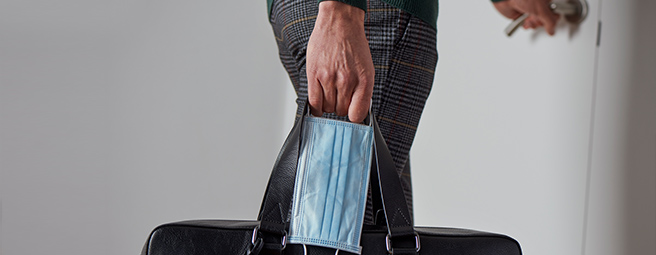
When Should You Go Back to Work After Being Sick?
You should go back to work after being sick when you are not contagious, the time of which varies depending on the illness (see below). You should also wait to return to work after being sick until you are feeling well enough to commute and operate machinery safely, and to think clearly enough to make important decisions.
Because of the COVID-19 pandemic, people are realizing how important it is to self-isolate when sick. Germs spread easily and when they do, the consequences heaped upon others is not only unfair, but unsafe. For these reasons (and more that are listed below), just stay home if you’re not feeling well.
3 Reasons Why You Shouldn’t Go to Work When Sick
If you’re wondering whether you should go back to work while sick, please take into account the three reasons why you should not:
1. Community Spread.
Infectious diseases can spread like wildfire. Any time your germs come into contact with people, there is a real risk of others getting sick as well. The best way of preventing this from happening is to isolate yourself, wear a mask, and wash your hands.
2. Hindered Ability.
Being sick, especially if you are on certain medications, can have a negative (and sometimes dangerous) impact on how well you can do your work. Some medications make you drowsy or slow down your brain’s reaction times. This can lead to poor decision making and the inability to operate vehicles, machinery, and tools safely.
3. Longer Recovery Time.
Rest is a key ingredient for recovering from illness. Your body’s immune system relies on sleep to boost its ability to make white blood cells that attack viruses and bacteria. Also, the relaxation and slower breathing that accompanies sleep reduces inflammation, the lower demand for calories allows your body to recharge, and the demands on your brain are reduced which puts you in a more positive mood. All of this helps you heal faster than if you were to run yourself constantly into the ground.
Incubation Periods, Contagious Periods, and Recovery Periods
There is a lot of unknown information surrounding the periods of incubation, contagion, and recovery. Let’s dive into each and clear up some of the confusion.
Incubation
An incubation period is the time between disease exposure and when symptoms begin. If the incubation period has passed and you did not get sick, either you were not infected or your antibodies fought off the infection. Knowing the incubation period for some common illnesses can help you know if you’re at risk of getting sick. It will also help you narrow down when/where/how you got infected. If you think you may be infected, practice social distancing during this time. It will decrease the risk of spread because you may be contagious before you feel any symptoms.
Here are the incubation periods for common illnesses:
• Bronchitis: 4-6 days
• Common cold: 2-3 days usually, but up to 7 days
• COVID-19: 5-6 days usually, but can range from 1-14 days
• Diarrhea (bacterial): 1-5 days
• Influenza: 1-4 days
• Pink eye (bacterial): 2-7 days
• RSV: 2-8 days
• Strep throat: 2-5 days
• Vomiting (viral): 2-5 days
• Walking pneumonia: 1-4 weeks
Contagion
A contagious period is the time during which an infected person can infect others. Generally, you will need to stay home from work until you haven’t had a fever for 12 hours without taking a fever-reducing medication, and you feel well enough to return.
Here are more specific contagious periods for common illnesses:
• Bronchitis: Onset of cough through 7 days
• Common cold: Onset of runny nose until fever is gone
• COVID-19: Limited data, but most likely during the 48 hours before symptoms appear and up to 8 days after feeling better
• Diarrhea (bacterial): Until stools are no longer loose
• Influenza: Onset of symptoms until fever is gone for 24 hours without medication
• Pink eye (bacterial): Onset of pus until 1 day on antibiotic drops
• RSV: 3-8 days usually, but up to 4 weeks
• Strep throat: Onset of sore throat until after being on antibiotics for 24 hours
• Vomiting (viral): Until vomiting stops
• Walking pneumonia: Up to 10 days
Recovery
A recovery period (sometimes called convalescence) is the time it takes to regain health and strength once you’ve become ill. You may still be contagious during this period.
Here are the recovery periods for common illnesses:
• Bronchitis: 1-4 weeks
• Common cold: 7-10 days, but up to 18 days for a lingering cough
• COVID-19: 2-6 weeks
• Diarrhea (bacterial): 2-3 days
• Influenza: 1-2 weeks
• Pink eye (bacterial): 2-5 days usually, up to 2 weeks
• RSV: 1-2 weeks, with lingering wheezing
• Strep throat: Up to 1 week after starting antibiotics
• Vomiting (viral): 1-3 days usually, up to 10 days
• Walking pneumonia: 1 week usually, up to 6 weeks
Note that these three periods often overlap in time. That’s why it’s so important to practice good hygiene, at all times.
How Long Viruses Live On Surfaces
Viruses are commonly spread from a sick person via touched surfaces that have been sneezed or coughed on, or by breathing infected air. A cough can spread as far as 6 meters (almost 20 feet) and a sneeze can travel 8 meters (26 feet). According to BBC Science Focus, “These droplets stay suspended in the air for up to 10 minutes.”
The Mayo Clinic says, “Viruses generally remain active longer on stainless steel, plastic, and similar hard surfaces than on fabric and other soft surfaces. Other factors, such as the amount of viruses deposited on a surface and the temperature and humidity of the environment, also determine how long cold and flu viruses stay active outside the body.” However, personal contact (such as shaking the hand of an infected person) is the most common way a virus spreads.
Here is a breakdown of how long some of the most common viruses can live outside the body:
• The common cold virus can survive on hard surfaces for several days, but they usually can’t cause infections after 24 hours. If the virus is on your hands, it can still be infectious for a few minutes, up to an hour.
• RSV can survive on hard surfaces for up to 6 hours, on soft surfaces for 30-45 minutes, and on skin for up to 20 minutes.
• The influenza virus can survive on hard surfaces for 24 hours, on soft surfaces for 15 minutes, and on hands for 5 minutes. However, it can survive in the air for at least several hours.
• The most common viruses that cause vomiting and diarrhea can last for a few days up to a few weeks on hard surfaces.
Conclusion
With the above information, it should be more clear when you should go back to work after being sick. If you are self-isolating due to being sick or to help combat the pandemic, learn the best practices for remote employees during the COVID-19 quarantine.
Are you struggling to get work done at home, but your office is still closed? Rent a temporary office space!
Categories
- Business Marketing
- Business Resources
- Customer Success Stories
- Customer Success Stories: Communications
- Customer Success Stories: Meeting Rooms
- Customer Success Stories: Virtual Office
- Entrepreneur Tools
- Management
- Meeting Rooms
- Virtual News
- Virtual Office
- Virtual Receptionist Services
- Workplace Culture
Subscribe to Our Blog
Archive

- December 2024
- November 2024
- October 2024
- September 2024
- August 2024
- July 2024
- June 2024
- May 2024
- April 2024
- March 2024
- February 2024
- January 2024
- December 2023
- November 2023
- October 2023
- September 2023
- August 2023
- July 2023
- June 2023
- May 2023
- April 2023
- March 2023
- February 2023
- January 2023
- December 2022
- November 2022
- October 2022
- September 2022
- August 2022
- July 2022
- June 2022
- May 2022
- April 2022
- March 2022
- February 2022
- January 2022
- December 2021
- November 2021
- October 2021
- September 2021
- August 2021
- July 2021
- June 2021
- May 2021
- April 2021
- March 2021
- February 2021
- January 2021
- December 2020
- November 2020
- October 2020
- September 2020
- August 2020
- July 2020
- June 2020
- May 2020
- April 2020
- March 2020
- February 2020
- January 2020
- December 2019
- November 2019
- October 2019
- September 2019
- August 2019
- July 2019
- June 2019
- May 2019
- April 2019
- March 2019
- February 2019
- January 2019
- December 2018
- November 2018
- October 2018
- September 2018
- August 2018
- July 2018
- June 2018
- May 2018
- April 2018
- March 2018
- February 2018
- January 2018
- November 2017
- October 2017
- September 2017
- August 2017
- July 2017
- June 2017
- March 2017
- February 2017
- December 2016
- November 2016
- October 2016
- September 2016
- June 2016
- April 2016
- March 2016
- January 2016
- December 2015
- November 2015
- September 2015
- August 2015
- July 2015
- June 2015
- March 2015
- January 2015
- November 2014
- October 2014
- August 2014
- July 2014
- May 2014
- April 2014
- January 2014
- October 2013
- September 2013
- June 2013
- April 2013
- February 2013
- January 2013
- December 2012
- November 2012
- October 2012
- September 2012
- August 2012
- July 2012
- June 2012
- May 2012
- April 2012
- March 2012
- February 2012
- January 2012
- December 2011
- November 2011
- October 2011
- September 2011
- April 2011
- March 2011
- January 2011
- December 2010
- October 2010
- September 2010
- July 2010
- June 2010
- April 2010
- March 2010
- January 2010
Talk to an expert
Want to know more about our Virtual Offices? Give us a call
Get the Perfect Virtual Address Now
Find a Virtual OfficeServices
Virtual Offices Virtual Office Features What is a Virtual Office? Full Time Spaces Live Receptionist Live Receptionist Features Virtual Phone Number Live Web Chat Meeting Spaces Meeting Space Features Coworking Spaces Event Spaces Marketplace Incorporation Services Search Virtual Office Services Near MeInstant Group
- © 2024 Davinci virtual office







